The festive season brings with it the joy of wrapping up in warm, cosy jumpers. Among the most cherished winter garments are Fair Isle and Norwegian jumpers, known for their intricate patterns and unparalleled warmth. These hand-knit treasures, often crafted from high-quality wool, are not only a nod to tradition but also a stylish addition to any wardrobe.
For those in the UK seeking the finest European sources for these beautiful jumpers, this article will guide you to the best retailers and artisans. Complete with helpful links and photo suggestions, you’ll discover where to find your next heirloom-quality wool jumper.
The Rich Heritage of Fair Isle and Norwegian Knitting
Fair Isle Knitting
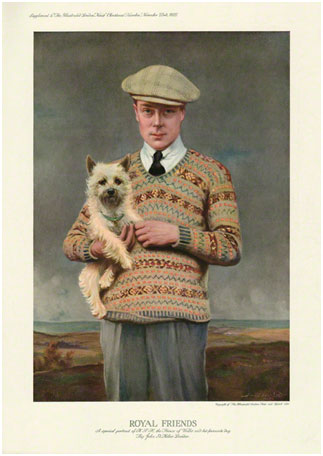
The famous image of the Prince of Wales, later Edward VIII, wearing a Fair Isle sweater in 1921. Photo credit Fraserknitwear
Fair Isle knitting originated on the tiny Fair Isle, part of the Shetland Islands in Scotland. This technique is characterised by its use of multiple colours and complex geometric patterns. Historically, Fair Isle knitting is believed to have been influenced by Scandinavian knitting styles brought to the islands by Nordic traders, though it has developed its own unique identity. The earliest documented Fair Isle jumpers date back to the 19th century, and the craft gained global recognition in the 1920s when the Prince of Wales (later Edward VIII) wore a Fair Isle jumper in public, igniting a fashion trend.
Since then, Fair Isle knitting has become a staple of the fashionable wardrobe, making frequent appearances on the catwalks of some of the world’s most renowned designers. Ralph Lauren prominently featured traditional Fair Isle jumpers in his first collection in the 1980s. Esteemed designers such as Alexander McQueen, Karl Lagerfeld, and Saint Laurent have also embraced these iconic patterns. More recently, British designer Molly Goddard has made Fair Isle a key feature in her latest catwalk collections, showcasing its enduring appeal and versatility.
Traditional Fair Isle patterns are known for their repetitive motifs and use of a limited palette, typically involving five or six colours but only two colours per row. This not only creates visually striking designs but also produces a denser, warmer fabric due to the stranded knitting technique. The wool used is often sourced from Shetland sheep, renowned for their soft yet resilient fleece.
Norwegian Knitting
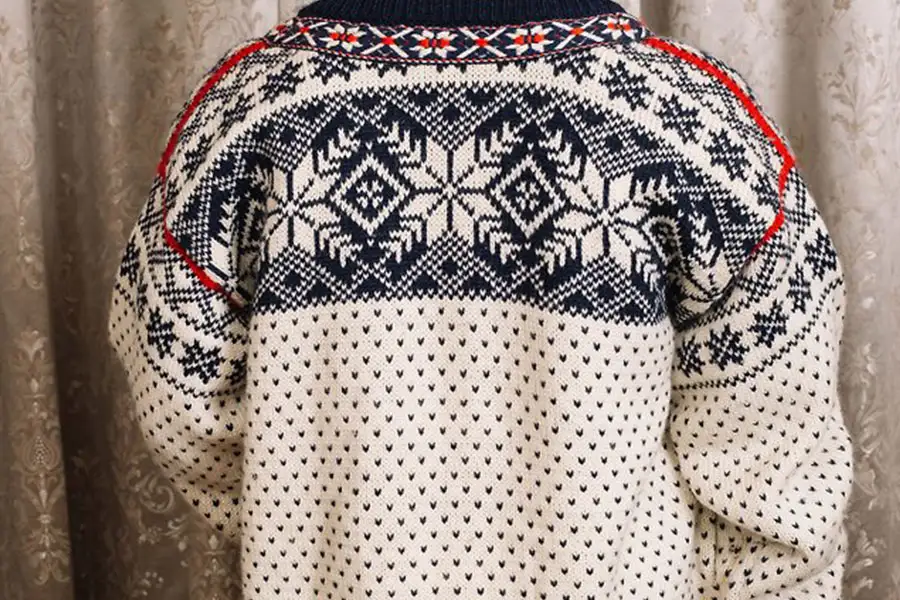
Norwegian knitting, particularly famous for the Selbu pattern, has a rich history rooted in the rugged landscapes of Norway. The Selbu rose, a star-like motif, became emblematic of Norwegian knitting in the mid-19th century when Marit Guldseth Emstad created the first Selbu mitten. The Lusekofte, or Setesdal jumper, another iconic Norwegian garment, features small black dots (lice) and intricate borders.
Norwegian knitting evolved from practical necessity—creating garments to withstand the harsh Scandinavian winters. These jumpers, typically made from local wool, are known for their durability, warmth, and distinctive patterns. The natural properties of Norwegian wool, which is coarser and more insulating, make these jumpers ideal for outdoor wear. The Visit Norway website has a wonderful article on the history of Selbuvotter, “Norway’s most famous mittens.”
Differences Between Fair Isle and Norwegian Knitting
While both Fair Isle and Norwegian knitting traditions share a love for intricate patterns and high-quality wool, they differ in their techniques and motifs. Fair Isle knitting is characterised by its stranded colourwork, where two colours are used per row to create intricate, repeating patterns. The focus is often on geometric designs and symmetrical motifs.
Norwegian knitting, on the other hand, often incorporates larger motifs such as the Selbu rose, and traditional jumpers like the Lusekofte feature both colourwork and textured knitting. Norwegian patterns are typically less repetitive than Fair Isle and often use fewer colours, focusing instead on the contrast between the main colour and the pattern.
The Benefits of Wool
Norwegian wool is breathable and insulating, keeps moisture away from the body, and is temperature regulating and self-cleaning. In Norway, children are dressed in wool from a very young age in order to keep them dry and warm regardless of the weather. Wool remains comfortable because it feels warm in winter and cool in summer. According to Visit Norway, “Norwegian wool is like wearing nature.”
Each year, around 4,000 tonnes of wool is processed in Norway. Norwegian wool is washed and prepared without chemicals, and is known for its strength and lustre. (Source: Norilia.no)
The Appeal of Owning a Genuine Handmade Jumper
Owning a genuine handmade jumper offers several advantages over mass-manufactured ones:
- Quality and Durability: Handmade jumpers are crafted with care and precision, often using high-quality wool that ensures longevity and warmth. The attention to detail and craftsmanship results in a more durable product.
- Unique and Customisable: Each handmade jumper is unique, reflecting the skill and artistry of the knitter. Many artisans offer bespoke services, allowing you to customise patterns, colours, and sizes to your preference.
- Cultural Heritage: Wearing a handmade Fair Isle or Norwegian jumper connects you to a rich cultural heritage and centuries-old knitting traditions. It’s a way to celebrate and preserve these time-honoured crafts.
- Sustainability: Handmade jumpers are often more sustainable than mass-produced alternatives. They typically involve local wool and support small-scale artisans, reducing the environmental impact associated with large-scale manufacturing.
- Comfort and Fit: Handmade jumpers are often made to measure, providing a better fit and greater comfort. The natural wool used is breathable, insulating, and naturally wicking, making it ideal for various climates.
Top European Retailers for Hand-Knit Woollen Fair Isle and Norwegian Jumpers
1. Jamieson’s of Shetland (Scotland)
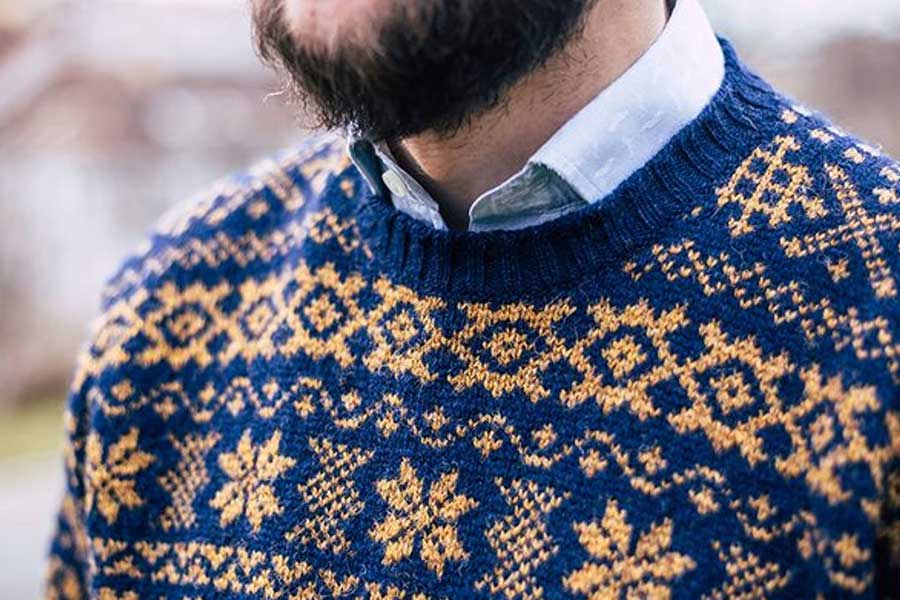
Jamieson’s of Shetland is one of the most renowned producers of Fair Isle knitwear. Jamieson’s is a family owned business which has specialised in woolen yarn and knitting for 5 generations. Established in 1893, this family-owned business sources its wool locally from Shetland sheep, known for their softness and warmth. A selection of Jamieson’s jumpers can be found on the Jamieson’s of Shetland website, while a broader range is available in upscale retailers across the UK and Europe, including No Man Walks Alone and Dick’s Edinburgh.
2. Dale of Norway (Norway)
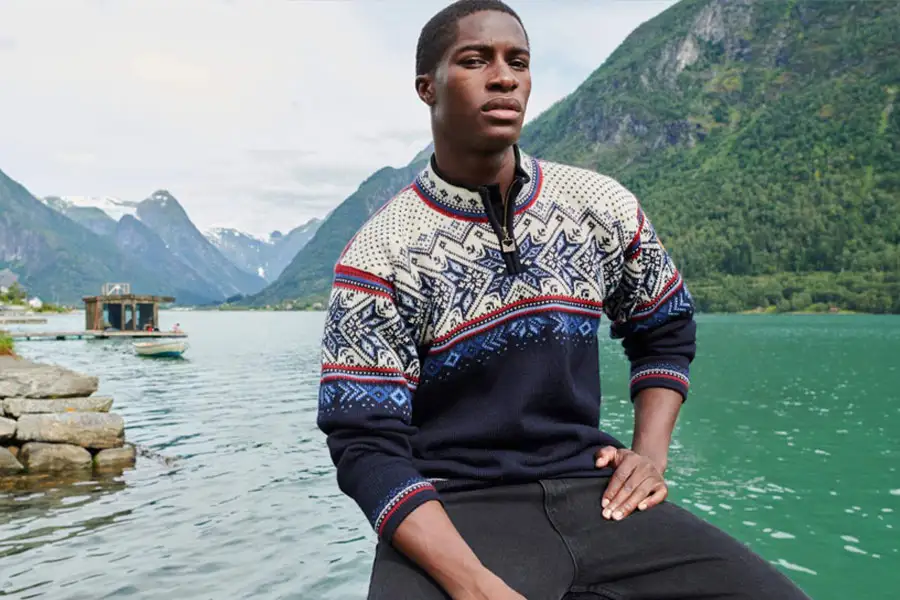
Dale of Norway has been producing high-quality Norwegian jumpers since 1879. They use Norwegian wool, which is exceptional for durability and warmth. Known for their meticulous craftsmanship and classic designs, their jumpers are often seen at international ski competitions. The Dale of Norway Vail Sweater (pictured above) was made for the Alpine World Championships in Vail, Colorado, USA and quickly became a bestseller.
Dale of Norway has created official garments for the Norwegian Olympic team at every Winter Olympics since 1956. The entire Norwegian Norwegian Olympic and Paralympic teams will be proudly wearing the official Olympic jacket “Mount Stello” for the 2024 Paris Olympics.
They also have seasonal designs for us Christmas jumper lovers who want a more sophisticated look.
Dale of Norway jumpers can be found at luxury boutiques, Norwegian gift shops, high end ski and sport retailers, and by searching Dale of Norway on Amazon.
3. Wool Wear (Denmark)
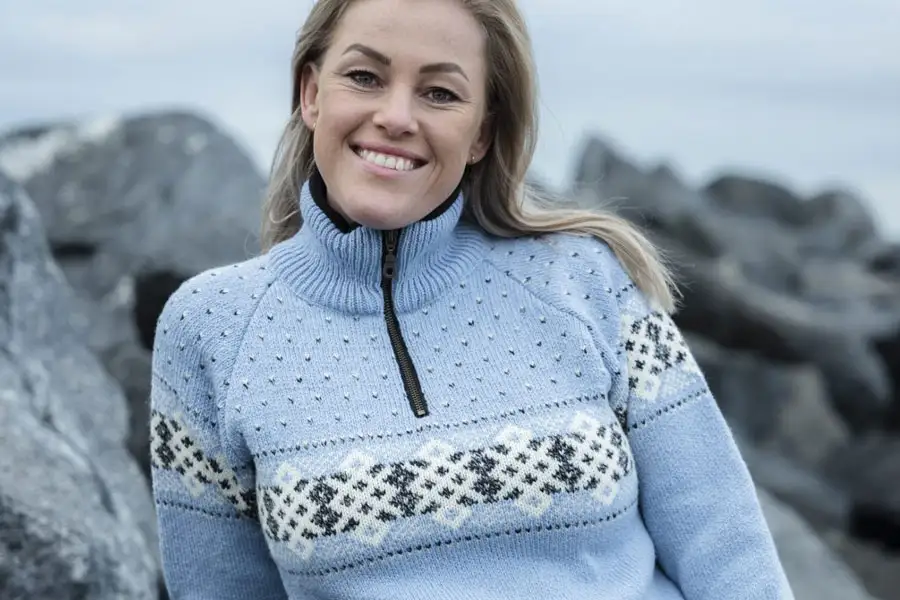
Wool Wear, based in Denmark, offers a stunning collection of hand-knit Norwegian and Fair Isle jumpers. Known for their exceptional quality and traditional designs, WoolWear uses pure new wool to create garments that are both warm and stylish. Their extensive range includes classic patterns and contemporary twists, ensuring there’s something for every taste. Each jumper is crafted with care, reflecting the rich knitting heritage of Scandinavia.
4. Icewear (Iceland)
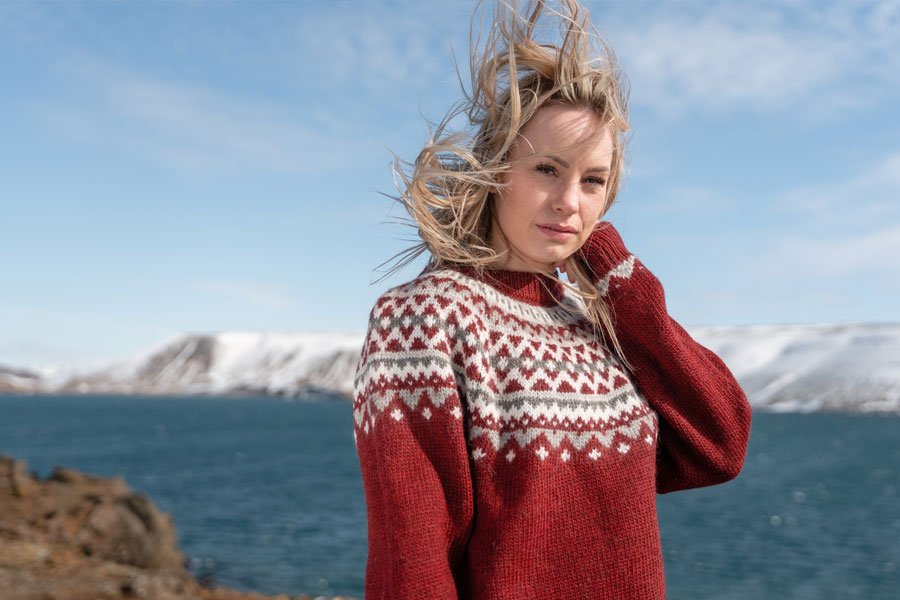
Icewear, based in Iceland, specialises in traditional Norwegian and Icelandic jumpers, offering a wide range of hand-knit garments that combine heritage with contemporary style. They began in 1972 as a simple knitting factory in the Icelandic village of Hvammstangi.
Using high-quality Icelandic wool, their jumpers are designed to withstand harsh climates while providing exceptional comfort and warmth. Icewear’s collection features both classic and modern patterns, making their jumpers a versatile addition to any wardrobe. Icewear is available directly on their website as well as a nice selection of Icewear jumpers on Amazon.
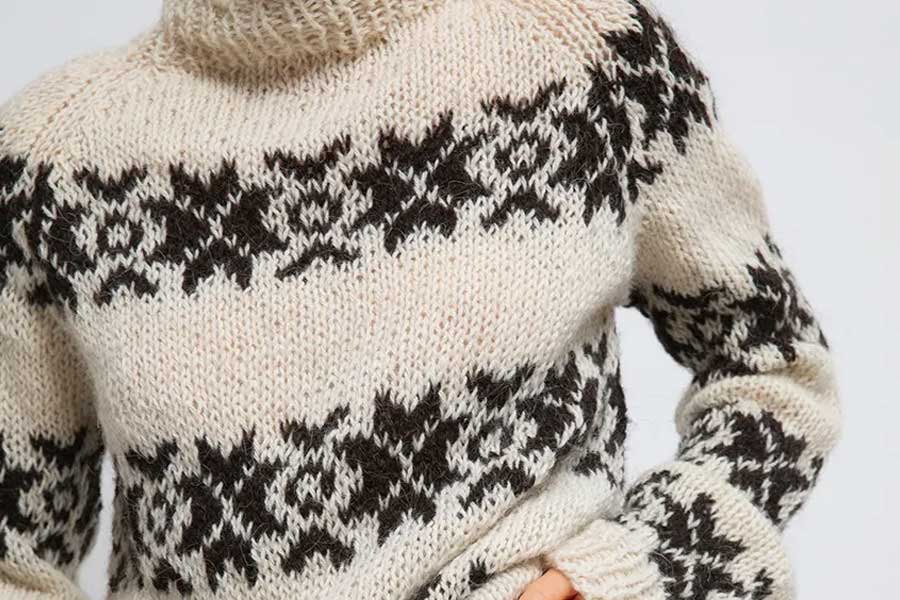
5. Guðrun & Guðrun (Faroe Islands)
Guðrun & Guðrun is a company based in the Faroe Islands, known for its commitment to sustainable fashion and traditional craftsmanship. Their bespoke jumpers are hand-knitted by artisans using locally sourced wool, and each piece is unique. They also emphasise the ethical production of their knitwear. Read here about that one sweater everyone is talking about.
Tips for caring for wool jumpers
- Less washing, more airing: Hang wool garments out to air instead of washing frequently. Use a humid environment like the bathroom after a shower for best results.
- Gentle stain removal: Spot clean stains with a damp cloth instead of washing the entire garment to preserve the wool fibres.
- Proper storage: Store wool garments lying flat to prevent stretching. Ensure they are clean and dry, and consider using a sealed container to protect from moths.
- Careful washing: Follow care labels. Hand wash at 30°C with wool detergent if required, or use a gentle wool cycle in the machine. Avoid wringing the garment.
- Drying and shaping: Lay flat to dry on a towel or drying rack. Shape the garment while wet and avoid hanging to prevent loss of shape.

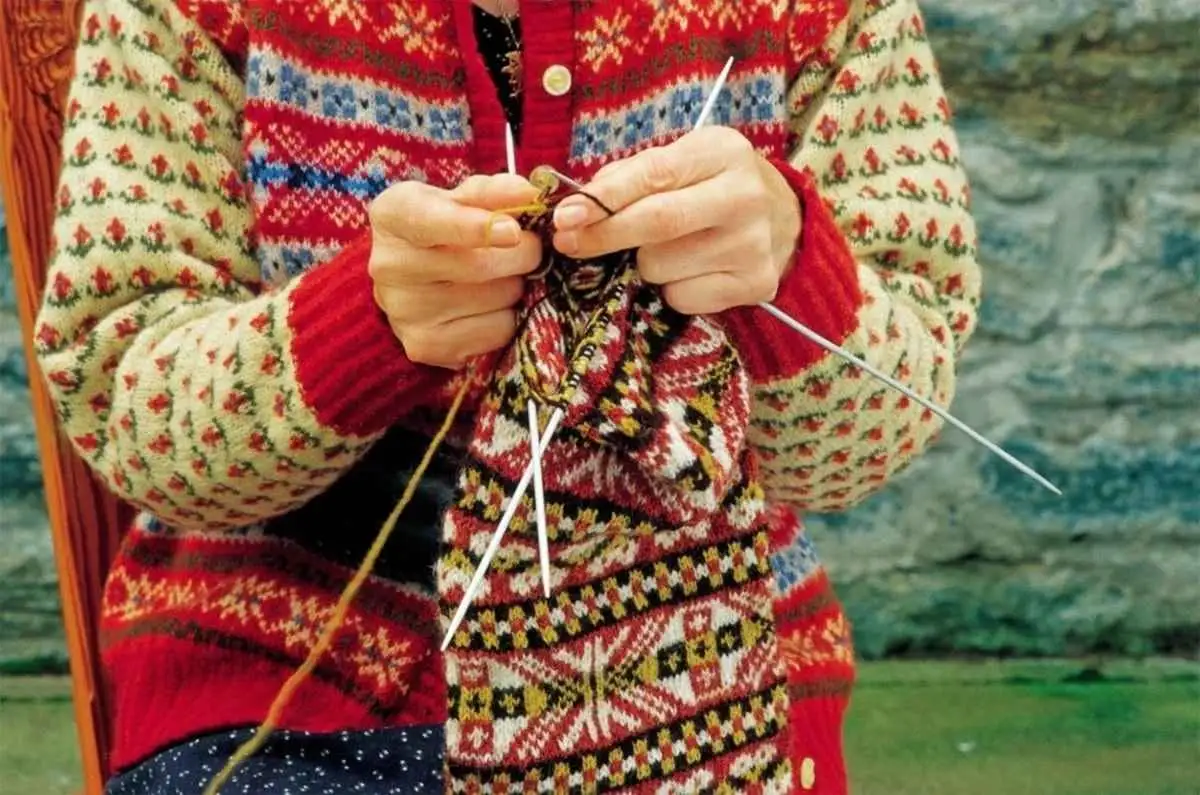





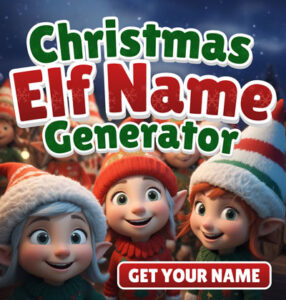
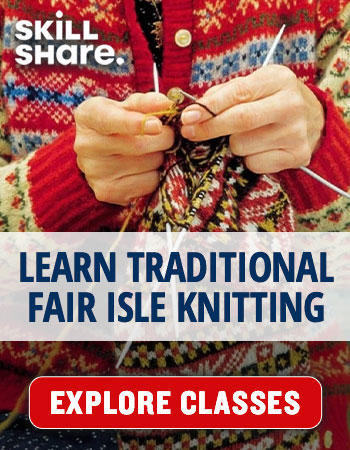
0 Comments